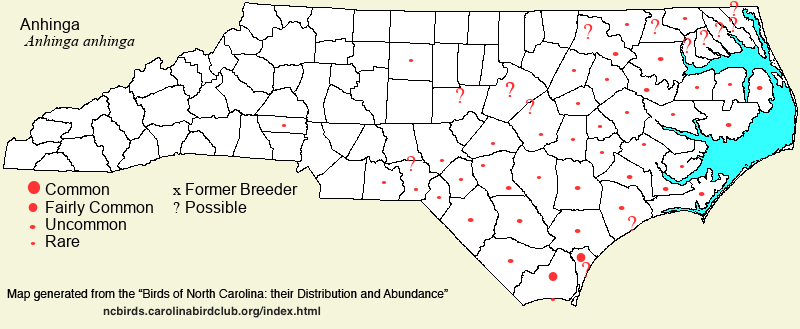 |  |
|
Anhinga - Anhinga anhinga Sole representative of ANHINGIDAE in NC | Search Common: Search Scientific: |
|
|
|||||||
| General Comments | The Anhinga is still another of the Pelicaniform species that has increased noticeably in the state over the past few decades. This increase might be due to a combination of an increase in beaver ponds, development of wetlands in Florida, and possibly to global warming. Unlike the Double-crested Cormorant, the Anhinga is not at all local in breeding sites, nesting now at several dozen sites scattered all across the Coastal Plain, as far inland as Weldon (Halifax), with an apparent nesting in the lower Piedmont in 2006 and a confirmed nesting in 2023. It requires fresh water and is never seen at salt or brackish waters. Large millponds, natural lakes with cypress, and beaver ponds are the usual places for nesting and foraging; the birds nest mostly in tall or medium-sized living trees, especially cypress, often in fairly exposed places. They also nest in some swamps, such as in the Roanoke River, where they can be found nesting with Great Blue Herons and Great Egrets. In fact, Anhingas typically nest with other wading birds. The species is often seen soaring overhead several hundred feet in the air, a seemingly odd behavior. It formerly was very rare in winter in the state, but such records are now greatly increasing; small numbers overwinter in the southeastern part of the Coastal Plain. | ||||||
| Breeding Status | Breeder | ||||||
| NC BRC List | Definitive | ||||||
| State Status | W | ||||||
| U.S. Status | |||||||
| State Rank | S3B | ||||||
| Global Rank | G5 | ||||||
| Coastal Plain | Breeding summer resident, increasing. Nests at least locally, scattered over most of the province, except apparently does not breed north of Albemarle Sound and does not nest on coastal/barrier islands. A few birds overwinter in the extreme southeastern corner of the state, such as at Wilmington; winter records are increasing, and birds seem now to be overwintering as far north as Pitt. Breeds inland to Weldon, Enfield, Jessups Pond (Cumberland), and Dunahoe Bay (Robeson). Uncommon and local (quite rare in some counties) over most of the province, but fairly common in the extreme southeast (Brunswick and New Hanover); generally rare north of Albemarle Sound, along the Outer Banks, and in other coastal areas. Mainly late Mar to mid-Oct, but many records into early winter, but rare in late Jan and Feb. Peak nesting totals: ??. Peak counts: 120 birds (and 50+ nests), pond in Bladen, 10 Jul 2024; 60, Goldsboro (after Hurricane Hugo), 24 Sep 1989. A count of 8 on the Pamlico County CBC, 18 Dec 2012, is perhaps a high winter season total. | ||||||
| Piedmont | Mostly a nonbreeding migrant/visitor; increasing. Now (2025) a casual but increasing breeder in the eastern and now central portion of the region. Primarily occurs in spring, though records for all months except Mar; more records in Apr and May than at other times. Rare to very uncommon visitor in the eastern portion of the province, especially in Wake and Durham; very rare to now rare in the western two-thirds of the region, including three records from Kerr Scott Reservoir (Wilkes). One nest was found at Jordan Lake (Chatham) in 2006, but it was not successful. Farther inland, successful nesting was noted at High Point Lake (Guilford) in 2023, with four adults and two active nests with six juveniles on 3 Jun. A nest with attending adult was found at Mosquito Den Swamp (Lincoln) in summer 2024.; birds had arrived there in 2025 as early as 5 Apr. At the eastern edge of the province, a few nests and 13 birds were noted on 13 May 2024 along Sapony Creek (Nash). Apparently nests, or has nested, at Pee Dee NWR (Anson); records there are nearly annual now, even in summer. Peak counts: 13, see above; 11, over Crabtree Creek (Wake), 14 Jul 2021; 10, Falls Lake, 20 Sep 2012; 10, Cowan's Ford Wildlife Refuge (Mecklenburg), 2 Jul 2019; 5, Durham area, 5 May 2002. | ||||||
| Mountains | Casual visitor. One was seen from a hawk watch at Mount Pisgah (Buncombe), 21 Sep 2003; one was seen near Mills River (Henderson), 21 Oct 2012; one was seen in flight over Lake Osceola (Henderson), 18 Oct 2014; and two were seen in flight over Max Patch Road (Haywood), 8 May 2022. | ||||||
| Finding Tips |
The spillway at Orton Pond is probably the best site in the state. Birds can also be seen at Twin Lakes in Sunset Beach, Greenfield Lake in Wilmington, Jessups Pond in southern Cumberland, and a handful of other lakes and ponds. Greenfield Lake might be the best place to look in winter. *** | ||||||
| Attribution | LeGrand[2025-07-27], LeGrand[2025-05-08], LeGrand[2025-02-03] | ||||||
| NC Map Map depicts all counties with a report (transient or resident) for the species. | Click on county for list of all known species. |
| NC Breeding Season Map Map depicts assumed breeding season abundance for the species. |  |